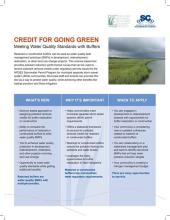
Pollutant Removal Credits for Restored or Constructed Buffers in MS4 Permits: Technical Memo, Final Report, and Summary
Vegetated land along the edges of waterways - also known as buffers - are widely understood to help protect water quality. However, until now there has not been a way to quantify the ability of restored or constructed buffers to reduce pollution, or for communities to receive credit for their use under regulatory permits. As a result, buffers have not been considered alongside other water quality best management practices (BMPs).
This innovative tool was created to help New Hampshire communities meet water quality standards through the use of buffers. The Credit for Going Green Project engaged a panel of experts to generate science-based recommendations to calculate the pollutant removal rate of restored or constructed buffers established on shorelines with different soils and slopes.
Communities can use this information to receive pollutant removal credits under permits issued by the NPDES Stormwater Permit Program. Municipal staff and boards can promote it as a way to protect water quality, while achieving the other benefits that buffers provide, like habitat provision and flood mitigation. This approach not only has the potential to enhance green infrastructure throughout the state, it also leverages the many opportunities for buffer restoration in New Hampshire.
About these resources
Project results are summarized here in three reports targeted for different audiences. In addition, the Credit for Going Green team's refined FAST Expert Panel Process has been documented to help others apply the method to complicated management problems, and the team's Credit for Going Green Outreach Toolkit offers a variety of tools to help project partners promote the work.
- Technical Memorandum: Presents pollutant removal performance curves, use cases, considerations for applications, and supporting decisions made by the panel. Intended for technical audiences such as consultants and municipal staff.
- Final Panel Report: Comprehensive overview of the expert panel ’s process, decisions, and products, along with information about the local contexts that led to the project.
- Non-Technical Summary: Two-page overview for general audiences such as conservation commissions and planning boards.
Primary Authors and Project Leads:
James Houle, University of New Hampshire
Cory Riley, Great Bay National Estuarine Research Reserve
Dolores Leonard, Roca Communications